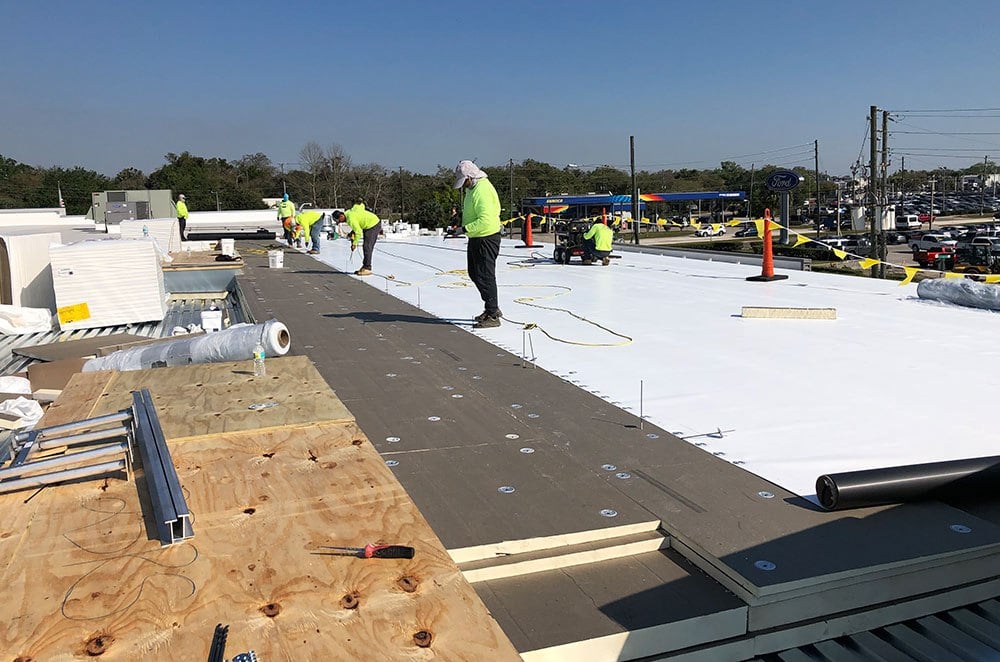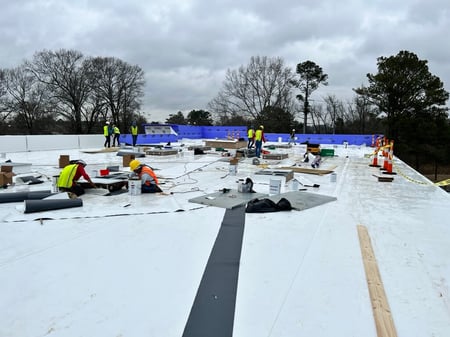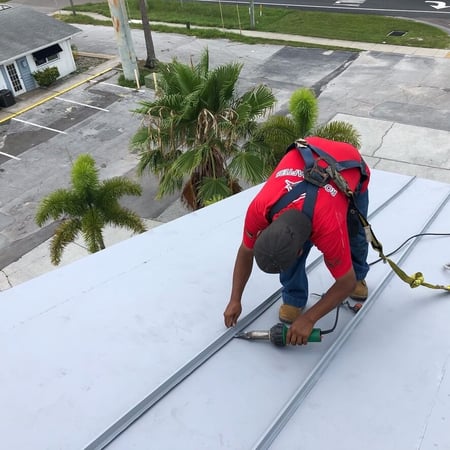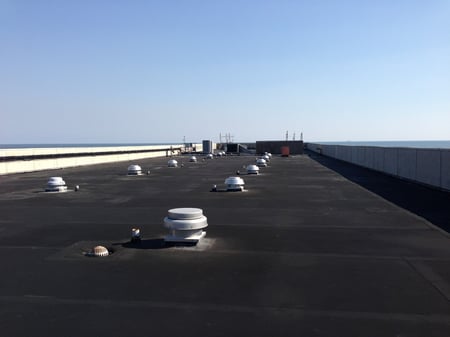What Are the Most Common Types of Commercial Roofing Membranes?
August , 2023 | 7 min. read
By David Toth

I’ll be honest, choosing a flat roofing membrane can be tricky. I know what you’re thinking: that’s so not something you want to hear a roofing contractor say, but it’s true! Tricky however doesn’t equal impossible in this scenario, especially when it comes to the 2 most common types of commercial roofing membranes: TPO and EPDM roofing. That being said, If you’re the proud owner of a flat roof, and you’re looking to explore the wonderful world of commercial roofing membranes, sorry to say, but you’re already at a disadvantage.
The water doesn’t drain off of your roof as fast as a steep slope roof. For example, let’s say you spring a leak. With the roof being flat, the water could be coming in from further away than where the leak is showing up on your ceiling, making it harder to detect and repair, even for the experts. Worry not, dear reader, as RoofCrafters has been repairing and replacing TPO and EPDM roofs for nearly 3 decades now though, and it’s safe to say that we know a thing or two about choosing the right membrane for your commercial roof.
We want to make sure commercial property owners are knowledgeable about their roofs before their contractor even shows up. If you’re reading this article, it’s safe to say you’ve had a question or 2 raised about TPO or EPDM roofing, and you’re wondering what your options are, and which material is best suited for your property. It’s a good thing you’re here because, in this article, I’ll be explaining what TPO and EPDM roofing is, their key features and benefits, and some factors to consider before choosing the material for your next roof installation. Let’s get started!
What Are the Most Common Types of Commercial Roofing Membranes?
A commercial roofing membrane refers to a type of roofing material used primarily in commercial buildings, such as offices, warehouses, factories, shopping malls, and other large structures. Roofing membranes are designed to provide a durable, waterproof, and weather-resistant covering for the building's roof.
The two most common types of commercial roofing membranes are:
Thermoplastic Polyolefin (TPO): TPO roofing membranes are made from a blend of polypropylene and ethylene-propylene rubber. They are known for their excellent weather resistance, UV protection, and energy-efficient properties. TPO membranes are typically white or light-colored, reflecting the sun's rays and helping to reduce cooling costs.
Ethylene Propylene Diene Monomer (EPDM): EPDM roofing membranes are composed of synthetic rubber, which offers excellent resistance to weathering, UV radiation, and ozone exposure. EPDM is available in large sheets, making it easy to install and suitable for flat or low-sloped roofs.
Both TPO and EPDM roofing membranes are installed in large sheets that are heat-welded, adhered to, or mechanically fastened to the roof substrate. These roofing systems provide a seamless and watertight barrier, protecting the building from water infiltration and potential damage. Commercial roofing membranes are popular choices because they are relatively low maintenance, durable, and offer long-lasting performance.

They are often used in combination with insulation layers to enhance energy efficiency and reduce heating and cooling costs in commercial buildings. Additionally, their installation process is generally faster and more cost-effective compared to traditional roofing materials like asphalt shingles or metal roofing.
What is TPO Roofing?

TPO roofing membranes are made from a blend of polypropylene and ethylene-propylene rubber, which are combined to create a durable and flexible material. Some key features and benefits of TPO roofing include:
- Energy Efficiency: TPO roofing membranes are often available in white or light colors, which helps to reflect sunlight and reduce heat absorption. This reflective property can lead to lower cooling costs for buildings and improved energy efficiency.
- UV Resistance: TPO roofing materials are designed to resist damage from ultraviolet (UV) radiation, which helps extend their lifespan and maintain their integrity over time.
- Durability: TPO roofing membranes are known for their durability and resistance to various environmental factors, including weathering, ozone exposure, and chemical damage.
- Environmentally Friendly: TPO roofing is often considered environmentally friendly because it can be recycled after its useful life, reducing the environmental impact of roofing materials.
- Easy Installation: TPO membranes are typically available in large sheets, making the installation process faster and more efficient. They can be mechanically fastened, adhered, or heat-welded to create a seamless and watertight roof.
- Versatility: TPO roofing is suitable for a wide range of commercial buildings with flat or low-sloped roofs.
- Cost-Effective: TPO roofing systems are often seen as cost-effective compared to some other commercial roofing options, making them a popular choice for various projects.
It's worth noting that the performance of TPO roofing can vary based on the specific manufacturer and the quality of the material. Therefore, it is essential to work with reputable roofing contractors and select high-quality TPO membranes to ensure the best results and longevity of the roofing system. Regular maintenance and inspections are also crucial to maximizing the lifespan and effectiveness of any roofing system, including TPO roofing.
What is EPDM Roofing?

EPDM roofing has been a popular choice for many years due to its durability, flexibility, and weather-resistant properties. Key features and benefits of EPDM roofing include:
- Weather Resistance: EPDM roofing membranes have excellent resistance to weathering, UV radiation, and ozone exposure. They can withstand extreme temperatures, from very hot to very cold, without becoming brittle or degrading.
- Waterproofing: EPDM roofing provides a highly effective waterproof barrier, ensuring that water does not penetrate the building and cause leaks or damage.
- Flexibility: EPDM is a highly flexible material, allowing it to expand and contract with changes in temperature without losing its integrity. This flexibility helps prevent cracks and tears that might otherwise occur with less flexible roofing materials.
- Longevity: Properly installed and maintained, EPDM roofing can have a long lifespan, often exceeding 30 years.
- Easy Installation: EPDM roofing is available in large sheets, making the installation process relatively straightforward. The sheets can be fully adhered to the roof substrate, mechanically fastened, or ballasted, depending on the specific application and roof design.
- Low Maintenance: Once installed, EPDM roofing typically requires minimal maintenance. Regular inspections and simple repairs, if needed, can help prolong its lifespan.
- Environmentally Friendly: EPDM is considered an environmentally friendly roofing option since it can be recycled after its useful life.
EPDM roofing is available in both black and white colors. Black EPDM roofing is the most common and provides excellent UV resistance, making it suitable for most applications. White EPDM roofing, on the other hand, offers increased energy efficiency as it reflects sunlight and reduces cooling costs.
Overall, EPDM roofing is a reliable and cost-effective choice for flat and low-sloped roofs, and its many benefits have contributed to its widespread use in the roofing industry. As with any roofing system, proper installation and regular maintenance are essential to ensure its longevity and performance.
TPO vs EPDM: Which Is Right for My Commercial Business?
Choosing between TPO and EPDM roofing membranes depends on several factors and specific requirements for your commercial or residential roofing project. TPO roofing offers excellent energy efficiency, with its reflective surface helping to reduce cooling costs. Its blend of polypropylene and ethylene-propylene rubber provides durability, weather resistance, and ease of installation.
TPO is a versatile option suitable for various flat and low-sloped roofs, making it an attractive choice for commercial buildings. On the other hand, EPDM roofing boasts exceptional weather resistance, UV protection, and flexibility, allowing it to withstand temperature fluctuations without losing integrity. With its long lifespan and low maintenance needs, EPDM is a reliable and cost-effective option for flat roofs. Additionally, its environmentally friendly characteristics, such as recyclability, add to its appeal.
To make an informed decision, it is essential to consult with roofing professionals who can assess your needs, recommend the most suitable material, and ensure proper installation and maintenance. Both TPO and EPDM offer reliable roofing solutions, and selecting the right one can lead to a well-protected, long-lasting, and cost-effective roofing system for your property. If you’re interested in learning which roofing membrane would properly suit your commercial business, be sure to hit the “Schedule an Inspection” button down below, and one of our roofing professionals will give you their expert analysis on which stellar option to choose!
My name is David Toth and I am the lead estimator in North Florida with RoofCrafters Roofing. Originally from New Brunswick, I have called Florida home for the past 47 years. I enjoy cooking along with traveling to different historical areas in Florida when I have free time.



